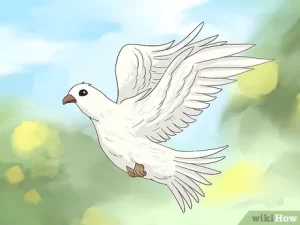
Bird Mating: An Overview
Courtship Rituals
Bird mating begins with elaborate courtship displays that serve to attract a mate. These displays can include:
- Vocalizations: Males often sing to establish territory and attract females. The complexity and variety of songs can indicate the male’s health and genetic fitness.
- Physical Displays: Many species engage in visual displays, such as puffing up feathers, dancing, or showcasing colorful plumage. For example, peacocks fan their tail feathers to impress potential mates.
- Gifts: Some birds present food or nesting materials to entice females. This behavior can demonstrate the male’s ability to provide for the female and future offspring.
Anatomy and Copulation
Birds possess a unique reproductive anatomy. Most birds do not have external genitalia. Instead, they have a cloaca, a single opening used for excretion and reproduction. During mating, birds engage in a behavior known as the “cloacal kiss,” where the male and female press their cloacas together to transfer sperm.
Exceptions
While most birds lack a penis, some species, particularly waterfowl like ducks and geese, do have a phallus. This structure is an extension of the cloaca and is used to facilitate sperm transfer, especially in aquatic environments where the risk of sperm washing away is high.
The Mating Process
- Preparation: As the breeding season approaches, hormonal changes in birds trigger mating behaviors. This usually occurs in spring when food is abundant, and conditions are favorable for raising young.
- Courtship: Males perform their courtship displays to attract females. Successful displays can lead to pair bonding.
- Copulation: Once a pair has formed, they engage in copulation. This process is often brief, lasting only a few seconds. The male mounts the female, and they align their cloacas to transfer sperm.
- Nesting: After mating, the female may begin to build a nest where she will lay her eggs. The male often assists in this process, providing materials and protection.
- Egg Laying and Incubation: The female lays eggs in the nest, which are then incubated until they hatch. Both parents may participate in caring for the young.
The Mating Process in Birds
Bird mating is a complex and fascinating process that encompasses a variety of behaviors, anatomical adaptations, and reproductive strategies. This section delves deeper into the specifics of how birds mate, including their courtship rituals, mating anatomy, the actual copulation process, and the subsequent nesting and rearing of young.
Courtship Rituals
Courtship is a crucial phase in avian reproduction, where males engage in elaborate displays to attract females. These displays vary widely among species and can include:
- Vocalizations: Males often sing to establish territory and attract females. The complexity and variety of songs can indicate the male’s health and genetic fitness.
- Physical Displays: Many species engage in visual displays, such as puffing up feathers, dancing, or showcasing colorful plumage. For example, male peacocks fan their tail feathers to impress potential mates.
- Gifts: Some birds present food or nesting materials to entice females, demonstrating the male’s ability to provide for the female and future offspring.
These courtship rituals are not only a means of attracting a mate but also play a role in species recognition and mate selection.
Anatomy of Mating
Birds possess a unique reproductive anatomy. Unlike mammals, most birds do not have external genitalia. Instead, they have a cloaca, a single opening used for excretion and reproduction. During mating, birds engage in a behavior known as the “cloacal kiss,” where the male and female press their cloacas together to transfer sperm.Cloacal Kiss: This act, which usually lasts less than a second, involves the male arching his body downwards while the female hunches down and moves her tail feathers aside. This position allows for the cloacas to align, facilitating the transfer of sperm from the male to the female.
Table: Key Aspects of Bird Mating
| Aspect | Description |
|---|---|
| Courtship Displays | Vocalizations, physical displays, gift-giving |
| Copulation Method | Cloacal kiss (most species), phallus (some species) |
| Breeding Season | Primarily in spring, influenced by hormonal changes |
| Nesting | Building nests for egg-laying and rearing young |
| Parental Care | Both parents may care for the young |
FAQ Section
How do birds choose their mates?
Birds often choose mates based on physical characteristics, vocalizations, and displays of fitness. Males with brighter plumage or more complex songs are typically favored.
Do all birds mate for life?
Not all bird species mate for life. Some are monogamous for a breeding season, while others may form long-term pair bonds. Species like swans and albatrosses are known for their lifelong partnerships.
How long does the mating process take?
The actual mating process is quite brief, often lasting only a few seconds. However, courtship rituals can take days or even weeks.
Can birds mate in any season?
Most birds mate during specific breeding seasons, which are influenced by environmental factors such as temperature and food availability. In temperate regions, this is typically in spring.
What happens if a female bird does not mate?
If a female bird does not mate, she will not produce fertilized eggs. In some species, females may still lay eggs, but these will be unfertilized and will not hatch.Bird mating is a complex and vital aspect of avian life, ensuring the continuation of species through various reproductive strategies and behaviors. Understanding these processes enhances our appreciation of these remarkable creatures. For more detailed information, you can refer to the Wikipedia page on Birds.


